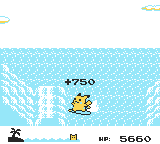Pokémon Yellow beta
Pokémon Yellow is a special edition of the Generation I games. It introduced the friendship system, which was improved and completed in Pokémon Gold and Silver and has since become a staple of the core series. It also added other features, such as walking Pokémon, which are exclusive to Pokémon Yellow and Pokémon HeartGold and SoulSilver, and the Pikachu's Beach minigame. Some aspects of the game's initial design did not make it to the final release, either due to time constraints or due to its heavy reliance and basis on Pokémon Red, Green, and Blue.
Pre-release
Evolution levels
In a news article on Pokémon.com about upcoming Pokémon games, it was mentioned that Pokémon would evolve at different levels to what they would in Pokémon Red and Blue.[1] However, the game had already been released in Japan at the time, so this may have just been misinformation.
Post-release
Hidden battle system
Data exists for a battle situation when the Trainer has no Pokémon, though it isn't actually used when entering a battle with no Pokémon in the final release. In this case, selecting any option other than Run shows the message "Hurry, get away!" In the Japanese version, this dialogue is written in an "old man" dialect, so this may have been intended to be used for Professor Oak during the initial battle with the wild Pikachu at the start of the player's adventure, as the player has no Pokémon at that point.
| |
| This video is not available on Bulbapedia; instead, you can watch the video on YouTube here. | |
Leftover music theme
An unused music theme has been encountered in the internal data. It is not known where it would be used, but it is possible that it relates to the aforementioned "no Pokémon" battle system. However, it is not stored in either the battle, overworld or cave soundbanks. It is located in the minigame and "special Trainer" (Jessie and James) soundbanks, where the Pikachu's Beach music is stored, which is partly why this track only exists in Pokémon Yellow.
| |
| This video is not available on Bulbapedia; instead, you can watch the video on YouTube here. | |
It may be worth noting that it closely resembles the battle music theme with Madake from BUSHI Seiryūden: Futari no Yūsha for the Super Famicom, a game that Game Freak developed and released in January 1997 after the release of Pokémon Red and Green, but before the Japanese release of Pokémon Yellow.
| |
| This video is not available on Bulbapedia; instead, you can watch the video on YouTube here. | |
Scrapped Pikachu's Beach bonus score
There is unused radness data for a score of +750 points in the Pikachu's Beach minigame. It is impossible to achieve this score, regardless of how many flips Pikachu does, or how they were performed.
Unused in-game trades
The Butterfree-for-Beedrill in-game trade from Pokémon Red, Green, and Blue remains.[2] The Japanese version of Pokémon Yellow kept the Beedrill's name from the Japanese Blue while the English version renamed it to Stinger.
Two additional in-game trades were also planned but scrapped, probably to compensate for the removal of the in-game trades in Cerulean City and Vermilion City. One is a Pidgeot for Pidgeot trade while the other is a Mew for Mew trade. In the Japanese version of Yellow, both received Pokémon have the same nickname, まつみや Matsumiya; however, in the English localizations, Pidgeot is nicknamed Marty while Mew is nicknamed Bart.
Default player and rival names
The unused default names for Red (Ninten) and Blue (Sony) remain unaltered.[3] In the Japanese version, Blue's unused default name remains unaltered from Pokémon Blue while Red's was subtly altered by gaining an extra digit (ゲーフリ1).[4]
Unused Pikachu Cries
Pikachu's voice actress Ikue Ohtani recorded 42 cries for Pikachu but 16 of them go unused.[5]
Semi-unused yellow palette
In Japanese Yellow on Game Boy Color mode, the game uses a yellow palette similarly to how Red, Green, and Blue use their respective red, green, and blue palettes. In Western Yellow, Game Boy Color mode instead uses the Super Game Boy palettes but with more saturated colors.
The yellow palette from Japanese Yellow is used by Western Yellow in certain situations like Pikachu's Beach hi-score screen and it can be reinstated completely by modifying the ROM.[6]
Virtual Console Changes
Jynx Sprite Color
Jynx's sprite color was changed in the Virtal Console release of Pokémon Yellow due to avoid further controversy. This also makes Jynx the only Pokémon in the game to use a fifth color palette that was added exclusively to the Virtual Console release.

|
This section is incomplete. Please feel free to edit this section to add missing information and complete it. Reason: back sprite |

|
| Front sprite |
Move Animations
The Virtual Console release of Pokémon Yellow (Japanese, English, and all other localizations) slowed down the rapid flashing animations for the following moves to comply with current seizure protection standards:
- Blizzard
- Bubble Beam
- Confusion
- Dream Eater
- Explosion
- Guillotine
- Hyper Beam
- Mega Kick
- Mega Punch
- Psychic
- Reflect
- Rock Slide
- Selfdestruct
- Spore
- Thunderbolt
Pikachu's Beach minigame
Pikachu's Beach minigame is now available to the player character's Pikachu regardless of if Pikachu knows Surf or not. The posters in the Summer Beach House are still programmed to give tips only if a Surfing Pikachu is present in the player character's party.
Cable Link Room Text Change
The message after trading or battling has ended was changed from "The link has been closed because of inactivity. Please contact your friend and come again!" to "Please come again!"
Trading
Wireless Trading was added to the game via using a modified emulator that imitates the Link Cable without affecting gameplay.
References

|
This game-related article is part of Project Games, a Bulbapedia project that aims to write comprehensive articles on the Pokémon games. |

